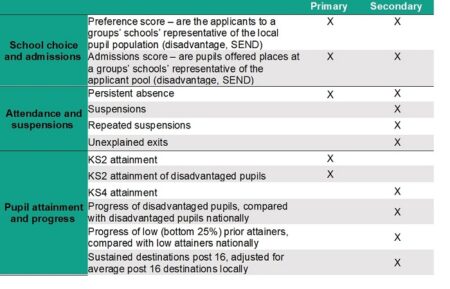EPI launches online tool to compare school group performance
Analysis finds that larger MATs typically achieve higher attainment and progress for disadvantaged pupils, but also have higher rates of absence and suspension when compared with other school groups

EPI has launched a new online web tool that enables users to build a more-rounded understanding of the performance of multi-academy trusts, local authorities, dioceses, and federations in England.
It allows users to benchmark performance between different school groups as well as compare the relative strengths and weaknesses of individual groups.
This project supports a move away from a historic tendency to focus on pupil attainment and progress to a wider set of criteria to judge the relative performance of schools and school groups.
This first release of the tool focuses on inclusion and attainment outcomes.
Further iterations will include measures of financial health and workforce indicators.
And its launch is accompanied by a new report which highlights some key findings from EPI’s latest analysis.
The report finds that:
- Across all measures there is considerably more variation within school group types compared to between school group types
- Larger MATs (with 10 or more schools in a phase) have, on average, higher rates of persistent absence, suspension, and unexplained exits than smaller MATs and local authorities
- Larger MATs admit greater rates of disadvantaged pupils and have higher attainment outcomes for low prior attaining and disadvantaged pupils
- The highest performing groups on overall attainment receive a lower proportion of applications from disadvantaged pupils and have lower rates of absence and suspension
- There are some differences between the school group types. The median local authority has a lower rate of suspensions than the median MAT, while the median MAT has higher progress scores for both disadvantaged and low prior attaining pupils than the median local authority
- Primary school groups linked to dioceses (MAT and non-MAT) have intakes that are less representative of their local area. However, they have relatively-low levels of persistent absence and relatively high overall attainment
The document also makes a number of policy recommendations, including:
- The accountability and inspection system should be reviewed, and consideration should be given to how it can better reflect the different pupil demographics and circumstances of individual schools. Schools that admit representative proportions of disadvantaged pupils or those with additional needs should not be penalised under any potential new system
- The Department for Education should now publish easily-accessible metrics for school groups, in line with its approach of ‘trust quality descriptors’. This would allow users to see the relative strengths and weaknesses of school groups and allow a more informed understanding of their performance and how they reflect their local communities
- The school admissions code should also be reviewed, with a focus on inclusion. In particular, it should consider why certain types of school groups (such as diocese) appear to be less likely to reflect their local areas in terms of the number of pupils from low-income backgrounds that they admit
Louis Hodge, associate director for school performance, admissions and capacity at the Education Policy Institute (EPI), said: “With large increases in academisation over the last decade, an increasing number of schools are now working as part of wider groups and networks.
“While previous research has largely focused on pupil progress and attainment, this research seeks to promote a more-balanced picture of the relative strengths and weaknesses of different school groups, aiming to identify those which achieve strong progress and attainment scores, alongside high standards in pupil inclusion.
“We hope that this online tool, and associated report, will help to promote informed conversations across the education sector about the features of effective school groups and how school groups can be supported to improve their performance.
“Given how schools’ attainment outcomes are impacted by different pupil demographics, this must be reflected in the school accountability system, ensuring that those who admit higher proportions of disadvantaged pupils and pupils with additional needs are not penalised and that best practice in pupil inclusion is recognised.”
Methodology
The tool and report explore a series of metrics developed by researchers to evaluate both the inclusion and attainment outcomes of school groups in England.
The focus is on three key areas, which the EPI believes help to identify an effective school group:
- School choice and admissions
- Attendance and suspensions
- Pupil attainment
The table below describes the metrics explored in this work.

In constructing the metrics, EPI pooled data from across three school years – 2016/17 to 2018/19 – to create an average result for each metric across that time period.
This period represents the latest three-year series of metrics unaffected by the disruption to schools during the COVID-19 pandemic.
By aggregating multiple years of data, EPI makes the results less sensitive to small pupil numbers or to characteristics specific to individual pupil cohorts.
